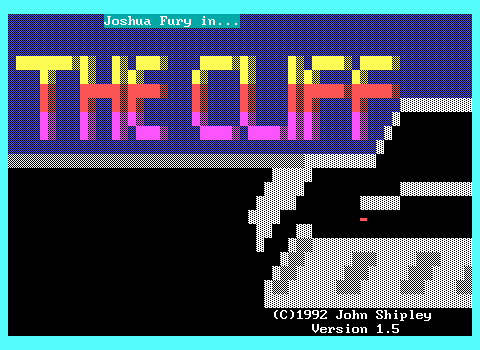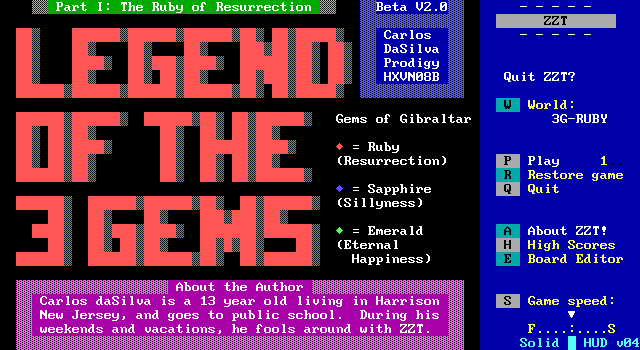
In early 1992 there's really not a whole lot of options for ZZT. While this era of preserved games has slowly grown mostly due to asie's work and the donations of others. It's pretty rough going. Not even getting into the discussion of what fraction of it survived thirty years onward, there's the question of just how much was ever available in the first place. ZZT fans would be scattered across various online services and local BBSes, likely with ZZT games being lumped in with any other game making it a challenge to specifically seek them out.
The lack of a single point of interest for ZZTers meant more than just struggles with finding games to play, it also meant that games would be developed in more insular bubbles. One's frame of reference for what a ZZT game could be, or should be was limited to little more than the official releases and whatever few titles you had access to. The title screen of a later release of Ruby of Resurrection mentions it being one of the first ZZT Club games, an early assortment of ZZTers including names like Carlos DaSilva, James Holub, Jerry Hsu, and Jesse Chang. To somebody with experience in early ZZT adventures, these are names will be immediately recognized, and sure enough this small group calling itself the ZZT Club produced titles with a shared aesthetic to them that's hard to describe, but clear when you see it.
A lot of these early adventures are pleasant to look it and feel rather creative for the time. They allow you to follow your way forward through ZZT's history seeing the games they influenced and what games those went on to influence. In my case, playing this so soon after streaming Chris Jong's The Big Leap, the similarities were uncanny. Yet the ZZT world moves fast, and despite the shared concepts in a globe-trotting adventure, with some time travel for good measure, the two feel years apart in terms of game design. This isn't a dig on Ruby or Carlos. Ruby is clearly a rougher title, but it's not bad, just one that will be overshadowed by its successors being able to refine the experience a bit more.
Where this one fits in ZZT's long history is one that's an early ambitious effort. There are a lot of ZZT worlds out there with a similar premise and gameplay, plenty of which succeed considerably more at the kind of adventure Ruby of Resurrection is trying to deliver. This game is a case of knowing your roots. Carlos didn't have the luxury of studying what came before him in ZZT that later authors would. Instead he's forced to make a bold stab at creation with rarely anything to learn from beyond the official Epic released ZZT worlds. Knowing the challenge that comes from being such a pioneer, it's no surprise that this game has some problems. Despite what refinements would come from later games by ZZTers with more mature tastes, Legend of the 3 Gems still offers some good fun. Don't let those standing on Carlos's shoulders to achieve new heights let you forget where it all started.
Jersey Jake

Our protagonist this time is "Jersey Jake", one of countless Indiana Jones would-be adventurers on a new quest for the fabled Ruby of Resurrection. Despite the clear parody, Jake isn't all that heroic. Neither brilliant nor bumbling, Jake goes through this whole journey unsure of whether or not to take his adventure seriously or not. Carlos enjoys breaking the fourth wall on occasion to make it clear that Jake is supposed to be the strong and courageous hero that ventures into dark crypts, booby-trapped caverns, and faces off against terrible beasts, chastising the player when they select more cowardly dialog options for Jake.
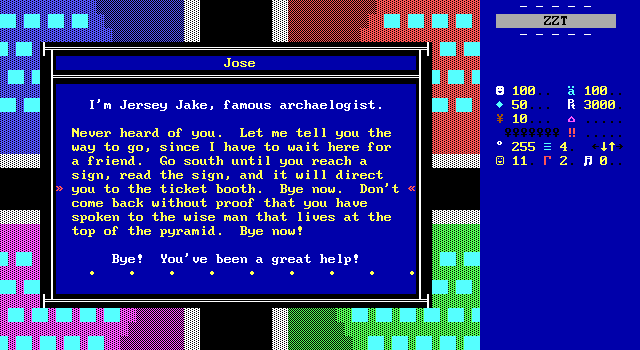
This doesn't really work because there isn't any commitment to Jake's personality. He's too goofy to be fighting Nazis for mythical artifacts. Ultimately capable, but in over his head, Jake is less Indy and more Pitfall Harry. He's just kind of a guy that's trying to get some treasures. He cracks a few too many jokes to make it believable that he's taking his adventure seriously. Unfortunately for Jake, many of these jokes don't really elicit laughter making him feel even less like a well-defined character.
In other aspects, which really boil down to a thirteen year old trying to write an experienced adult with a job descriptions that's exaggerated to the fantastic. Jake is a "direct archaeologist" (if I can coin the term) which fits Indiana Jones as well, but when Indy is thrust into wild scenarios he has the knowledge and experience to help navigate them. Jersey Jake meanwhile, flies to Mexico City, and gets confused when somebody speaks to him in Spanish.
Jersey Jake as a comedic parody who escapes deadly situations via sheer luck could absolutely work as a character. It's just that there's no commitment to that personality either. He's equal parts capable and cowardly which in turn just makes him feel like a guy who happens to be there to advance the story of the game.
The Grand Adventure
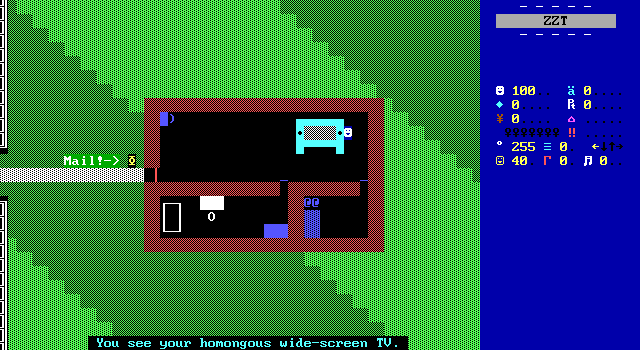
The game begins in Jersey Jake's sparsely furnished home where Carlos thanks the player for giving his game a try. Notably he says that "I try to make each of my adventures as realistic as possible", which specifically refers to how many objects are placed on boards. Already I'm questioning this. It's not completely unfounded. If you take a look at the early houses shown off in ZZT House Hunting, then what Carlos puts into his world is a step up compared to early titles like Town and Smiley Guy to be sure. Yet a home with six items to interact with spread between a living room, bathroom, and bedroom really doesn't evoke feelings of considerable detail.
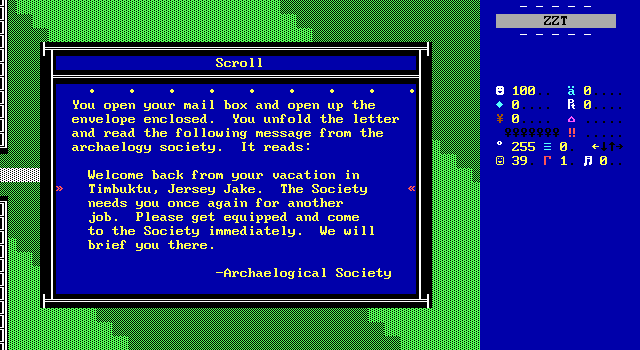
Outside, his mailbox can be checked which gets the game rolling. Freshly back from a vacation in Timbuktu, Jersey Jake receives a letter from the local archaeological society telling him to get equipped and head to the society as they have a new job for him. The mail also contains a form for a sweepstakes being ran by Ed McMahon which I would normally save mentioning for discussing this game's interesting ideas of humor, but it will in fact be plot relevant.
Jake makes his way through the local museum where the archaeological society resides before receiving his new mission: to find the fabled Ruby of Resurrection so that the museum can get some more floor traffic. The ruby was last known to be held by King Leroy who set up tests to be overcome to be declared worthy of receiving the jewel. The ruby is in fact capable of resurrecting the dead as its name would imply, but the main story seems to have no interest in this and just wants it as a museum exhibit. Jake shows his sheepish side and is surprised at the idea that he'd somehow be able to complete the tests, but of course the player has to accept the task if they want to keep playing.
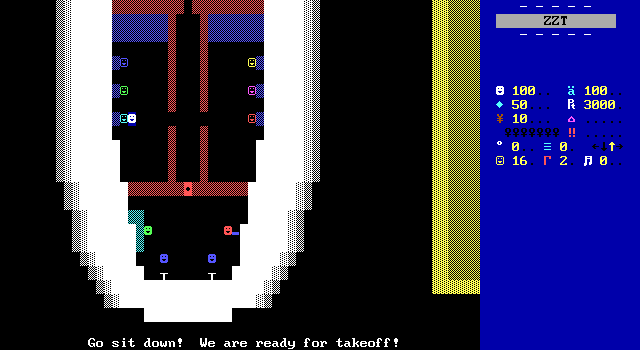
Jake is shuffled off to the airport where a ticket to Mexico City has been purchased in his name. Just FYI the ruby is not suspected of being in Mexico City. Or Mexico. Or the Americas. Nonetheless, that's Jake's stop and after finding his gate and boarding the plane he's whisked away.
In Mexico, Jake runs into Jose and explains his quest saying that sources say there's some information in one of the old Aztec ruins. Jose mentions a friend found a secret passage there while waiting in line to buy a ticket for a proper tour. Jake suggests sneaking in, but Jose explains that the tickets are cheap enough that it's not worth the hassle. Despite Jake having the money for a ticket based on a sign, there's no option to actually pay for one and he has to find the secret passage and sneak in regardless. It's faster than waiting in line at least.
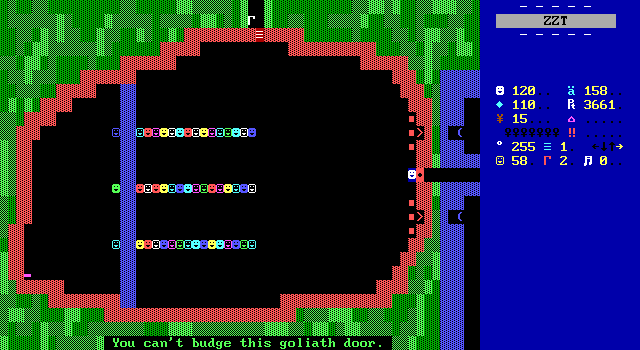
Upon finding the secret passage behind a statue, Jake enters the ruins and gets to make his way through a few dark boards containing mazes and spinning gun traps. It's rough stuff that'll be covered more in depth later, but story-wise he makes it to a massive statue that comes to life and requires him to answer a riddle or die. I won't tell you the riddle right now, but you stand a reasonable chance of guessing the correct answer solely by me saying "you have to answer a riddle".
The riddle is answered and Jake received the "Sceptor [sic] of Changes". The path splits in two with the god who has brought the statue to life explaining that one path is safe while the other is protected by the fiercest Aztec warrior. Regardless of path taken, Jake makes his way back outside and shows the staff the to a hermit that lives next door to a giant tourist attraction. The hermit offers to help Jake however he can. So Jake does the sensible thing and asks the hermit for the key to the hermit's brother's hotel suite. A character never mentioned by either of the two characters prior.
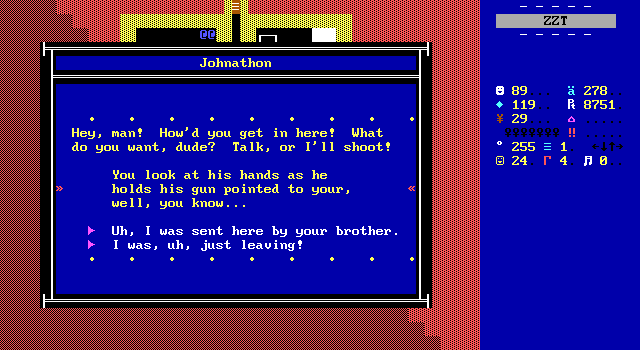
After a brief struggle of finding the address, Jake makes it into the hermit's brother's hotel home, and is immediately accosted with a gun pointed at his junk for trespassing. (You can see the screenshot, I'm not kidding.) Jake clears up the confusion by explaining how he was sent by the hermit. For this, he is granted a wish! Jake wishes to make a phone call, rings up the archaeological society, and they let him know that they have arranged a ticket for him to travel to India. Nothing has been learned about the ruby or its whereabouts.
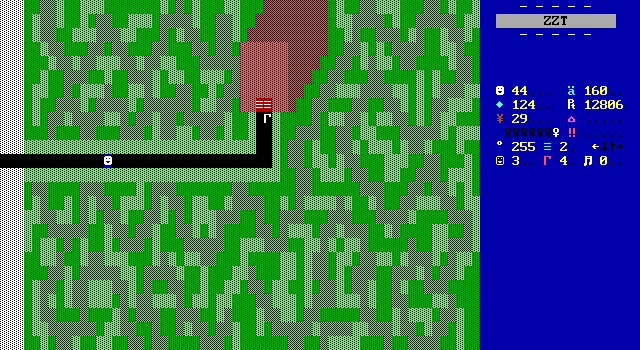
Landing in "India" Jersey Jake is immediately arrested under the orders of Prince Perashku with no idea why. He escapes from what may be ZZT's dullest prison, solves some more puzzles of mostly dubious quality, and finds and kills the prince in a fight. As he attempts to leave, Jake finds himself stuck in a room filled with breakable walls and uses the magic scepter to get rid of the walls and make it to a private "relaxation chamber" owned by the deceased prince.
Inside is... a portal back in time.
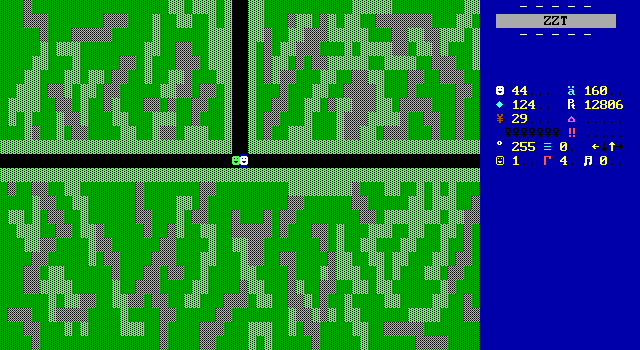
The portal takes him to England in the year 1200 where he meets up with a new Jose-style helpful friend: Timothy of the Sweeney family. Timothy actually moves things along and is familiar with the ruby which is located in King Leroy's castle just next to the village. Tragically, Leroy took his own life a decade prior after becoming disappointed in the lack of a worthy heir for the ruby. Timbo invites Jake back to town which features a few unique shops that exist for the purpose of an item trading quest, with a bakery, armory, shoe store, and more where Jake can't do anything except offer up an item if he happens to have the right item. Talking with Tim in his doctor's office starts the quest chain with the goal of finding a way to get rid of a troll by the fountain which has some information required to successfully complete the first of King Leroy's tests.
After going from "able to ask Timothy for a favor" to "having a pie", Jake can get rid of the troll plus get both a key and some cryptic information from the fountain. The key opens up the castle and Jake gets to conquer the legendary challenges which consists of actions and puzzle boards that wouldn't make the cut for a game like Town. From there Jake acquires the ruby, defeats a troll, and revives the king. The time travel aspect is weirdly disregarded as the revived king discusses Jake's strange attire and is told that it's 1992. This would make sense if it was "this is how we dress in 1992", but the king goes on to say how the gods told him that he would awaken again in 1992. Jake gets to keep the ruby and gets a big cash reward from king Leroy before finding another time portal because this isn't 1992, and uses it to return to 1992. He arrives in the museum right on top of the caretaker's desk and presents the ruby. Mission accomplished. Coming soon: the sequel.
A Lack of Sequels
While Ruby is very much self-contained, the title screen calls itself Legend of the 3 Gems Part I: The Ruby of Resurrection and shows of the two other "Gems of Gibraltar", the Sapphire of Sillyness, and the Emerald of Eternal Happiness. The rest of the trilogy doesn't have anything favoring its existence, with Carlos sticking around with ZZT few a few years, and garnering some attention for his attempted ZZT clone/sequel Z2. Long story short, if he had released the other games in the trilogy, he was out there enough that even if we didn't have copies, we'd surely have run into somebody who once did.
On its own, that's hardly anything unusual. Countless ZZT games end abruptly with plans for sequels that never materialize. What makes Ruby different in this regard is that Carlos did return to the game for later re-releases where he toned down the references to this game being part of a series. A 1996 release drops the "Part I" from the title and gets rid of the sapphire and emerald on the title screen. This version also replaces some text and contact information to make it more accurate to the time of its release as well as plugging Z2 (still called "ZZT 2").
Our only other non-Z2 release by Carlos DaSilva is yet another copy of this game, this time as Raider of the Lost Gem. This one is the most interesting of all. It's essential a full rewrite of the game. Graphically everything looks the same, but the writing presumably is improved by Carlos being four years older. In this release you play as "Arizona Smith" and it feels a bit grittier. My complaint that Jersey isn't very Indy seems to have been answered by Arizona though now the difference between the feel of the writing and the feel of the gameplay make this seem like a rather peculiar game to run through.
Gameplay and a Lack Thereof
That all gives us the story told throughout Ruby and what it looks as you go through it. The obvious question that still remains is what does this world play like? It's a question best answered with a shrug of the shoulders and an "eh" sound. Ruby of Resurrection is playable for the most part, and when what you're playing is just exploring the world it's decent enough. Comparing this to other 1992 worlds, this is about what you'd expect. It's the sort of game that understands what objects can be used for in order to guide the player while still lacking in how to use objects to enhance gameplay.
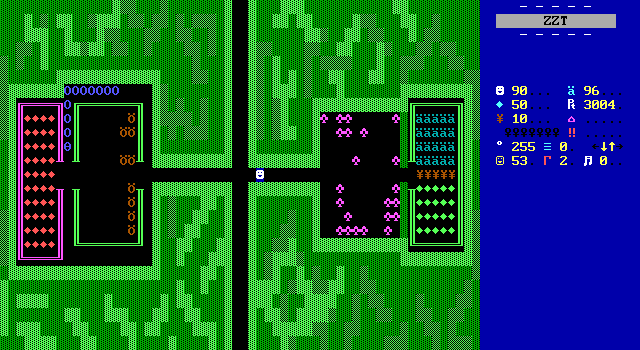
In short, that means must of Jersey Jake's adventure within the Aztec ruins, prison escape, and king Leroy's castle doesn't amount to much. Expect lots of shooting of tigers in between the more creative and interesting scenes. Some boards get it a little better like these two pockets of foes with rewards on the path to the Aztec ruins. Even this is still only a step above breaking out the fill-tool to create encounters.
The ruins open with two secret passages to uncover by pushing boulders through a transporter which in turn becomes a guessing game of which path to take with the wrong choice being ultimately fatal.
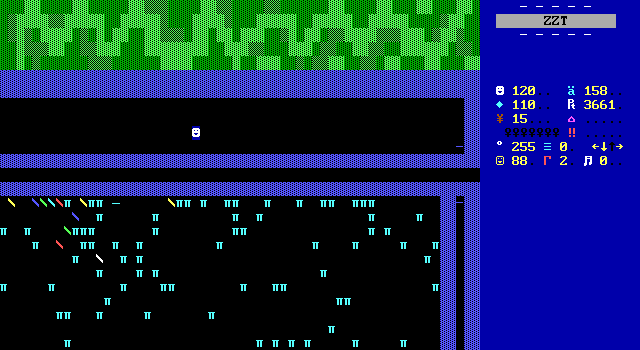
You can probably guess which is which.
Despite the fact that Jake can go south from the room full of tigers it only leads to another room with tigers and a dead end. It's a cruel trick that adds nothing to the experience and is a far better example of a poorly implemented forced (not even instant) game over compared to the criticisms of Warlock Domain in the previous Closer Look.
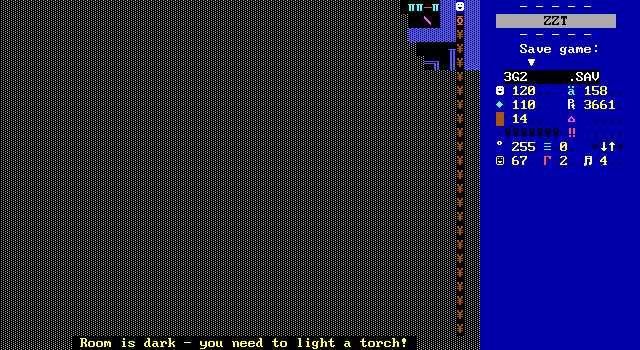
The correct choice is only slightly better. A column of torches is provided before a dark maze that first tasks the player with finding a transporter they can enter and then turns into a dark transporter maze. This is dull more than it's miserable at least with the maze not being too tricky to navigate and a reasonable amount of torches given to the player as they enter.

What is miserable is that this is then followed up with a dark invisible maze. Halfway through I just turned the lights on as this could potentially be massive to explore and likely even worse as there's no indication that the southeast is where the exit is. It of course leads to a needless ping-pong-path whose only saving grace is that its existence means that the invisible maze is slightly smaller.
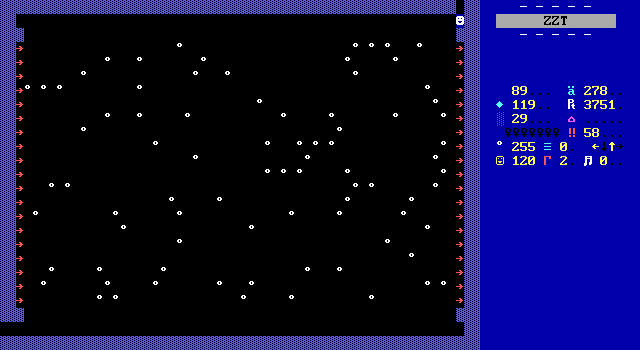
Then you get a dark gauntlet of spinning guns where you'll be sent to the start of the room if you get hit. I did try to do this one legit for a bit as it's mostly walking in a straight line and just keeping your eyes open for bullets that enter your torch's light and reacting quickly enough. It's a bit much with the firing rate on these guns combined with darkness.
Could you do this? I'm sure you could. Would you want to? No.

Getting to answer the riddle of the sphinx in this multiple choice format is a welcome break. The scepter is given as a reward with another choose the right door scenario presented for how to continue.
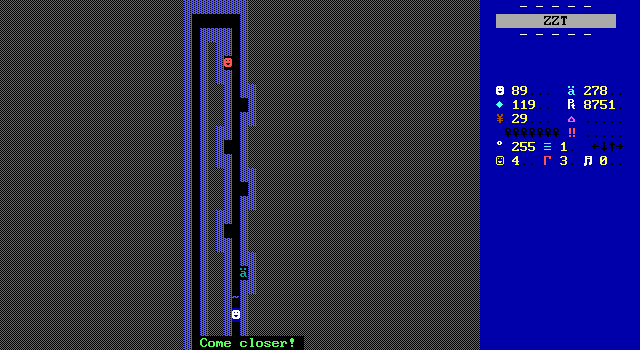
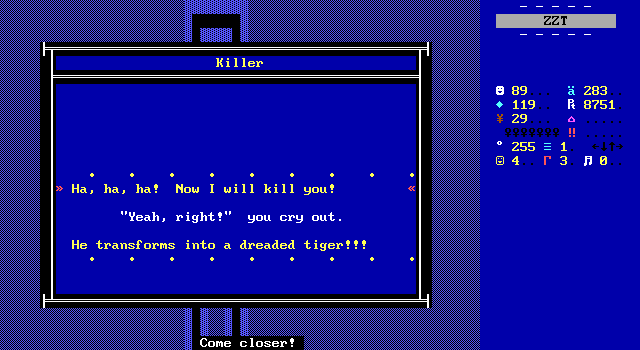
Luckily for me, the wrong choice is meant to be humorous. (I hope.) A lone object turns into a tiger and Jake is free to run outside.
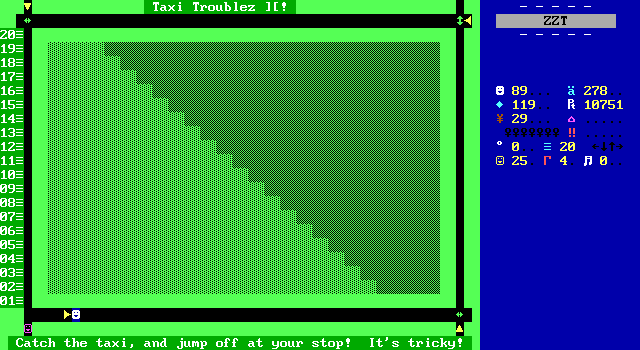
Oh! I almost forgot! Each flight involves taking a "taxi" to the right gate for your flight. Make sure you pay attention when you pick up your ticket at the front desk or you're going to be in trouble here. The taxis are objects and not pushers which is important only because these move at cycle one rather than cycle four which really makes it a challenge to enter the correct passage.
The long windup to the pusher object that actually matters makes an original if non-spectacular puzzle itself a bit boring. The wrong gate leads to a "WRONG GATE" board where you're given a game over for the mistake.

The prison break is as boring to play as it is to look at with the exception of this puzzle here. It's different from much of what the game considers to be a puzzle and despite looking scary this is no traditional slider puzzle. The player's input is limited to just pushing four possible sliders out of the way and letting the pushers do all the work. The difference in appearance to its difficultly works in its favor providing the satisfaction of solving a scary board without the usual time investment required in figuring out a well-constructed slider puzzle.
The positioning of the pushers also adds a little spice to the challenge. I'm not sure how intentional it is that pushing a slider up versus down can effect if you can even access a pusher's neighbor. Some might consider it a cheap trick. I appreciated the extra moment of realizing that there was more to it than just pushing in the right now.
Solution (from top to bottom):3, 2, 4
It's too bad that immediately after on the very same board is a fake wall maze to round out the trifecta. Kind of. You don't have to rescue this guy, though you do get ammo, gems, and health for it. Seeing as how I was completely out of ammo before talking with him, it's not something very skippable.

Then it's on to this Oktrollberfest entry of a puzzle. My first impression was that there was a mistake in the board and that this was unwinnable. Then I realized I was being silly and that there was just going to be a fake wall to find.
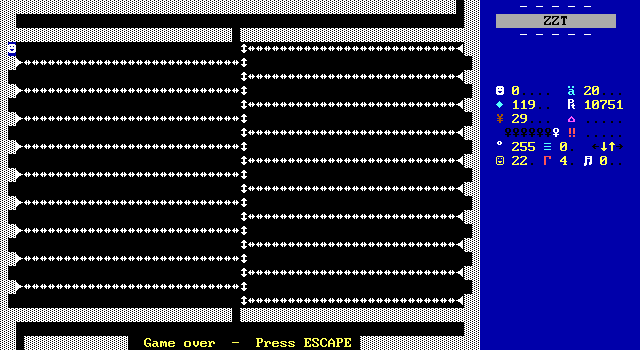
Whoops. Except if you touch stand adjacent to this one wall to search for a fake you're killed instantly. In a few instances throughout Ruby of Resurrection a custom game over message is intended to display that ends up immediately being replaced with the stock game over text. This wall is named "GrimerReaper" and is supposed to say "Too bad... Try again!" offering no closure as to what on earth just happened.
Instead you're intended to touch the topmost vertical slider which is a hidden object. Ah.


You can figure out what this scroll being here means.
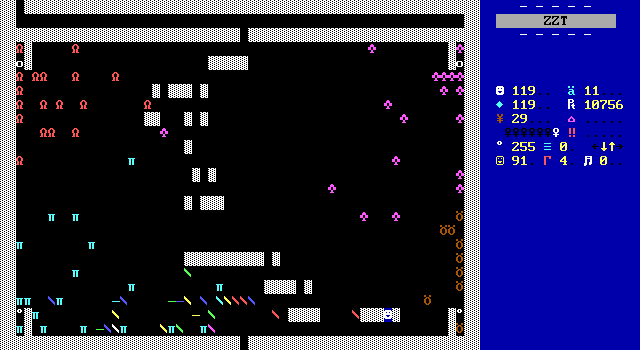
And the tigers are the star throwing variety too. This isn't really a maze. The invisible walls are all horizontal lines with multiple gaps on each row so it's more just stalling the player while the enemies appear and with almost no ammo left it gets very dangerous by the end.
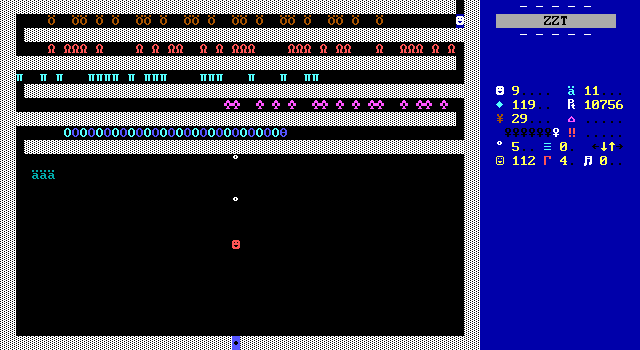
Even if you do conserve ammo there this leads to an atrocious ping-pong-path of enemies that makes getting through the game without cheating near impossible. I picked up all the optional ammo I came across and have 11. There are more than 100 enemies on this screen to get past. So... cheating time right? Right.
UNLESS...

Way back in the Aztec ruins when you first pick the correct path there's a fake wall that lets you get into a middle path that I figured I'd just reach later. This leads to what is undoubtedly a mandatory bonus room. Here an object asks who authored The Stolen Gems and a correct answer allows passage inside. (Rather courteously this information is revealed in the museum earlier so having access to other ZZT Club games isn't necessary to figure it out.)
In what is one of the weirdest things I've ever seen in a room filled with ammo and gems, the object then offers to just give you all the gems and ammo rather than make the player spend a minutes hoovering everything up. It's amazing to see an acknowledgment that this kind of thing is not enjoyable.
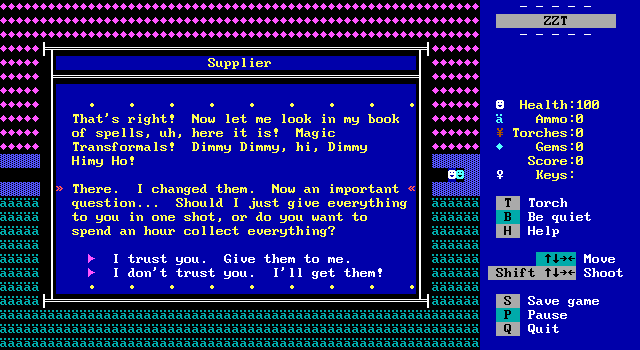
Alas it's framed as a "trust" issue. Saying no will get the object to complain however the player is free to collect everything themselves. Saying yes has dialog implying that you are indeed getting a fair deal, but you absolutely aren't. You get 67 gems, 67 health, and 325 bullets for accepting the offer.
Take a look at that screenshot of the bonus room, and then consider that a complete row of each provides 60 gems and 300 bullets. I'm so very confused by this. Is this an oversight? deception? The behavior here is carried forward unchanged throughout the two other versions of this game the museum also offers. I really don't understand it.

In my case I opted to cheat for ammo a few times and then clip across the first half and just fight the prince. The prince just tries to move and shoot towards the player endlessly, at a reasonable cycle two allowing the player to out-shoot him if needed. It only takes three hits to defeat him and get the exit to open.
I appreciated the irony of him giving 100 ammo when defeated.
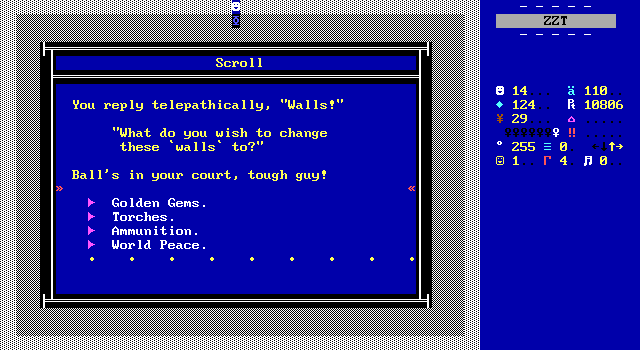
Then you get another multiple choice puzzle of how to get rid of the walls. Unlike the Aztec god's riddle all of the options here work though that same god whose borrow you're borrowing through the staff chastises you for trying to get items out of it. Picking "World Peace" gives Jake a little bit of everything instead for not being selfish.

After defeating Perashku and escaping his palace there's another odd idea here where Jake is on a time limit to escape the board before the guards catch up to him. There's nothing on this board though. You have the locked door to the time portal and a scroll describing it. If the player skipped the slider puzzle then they are technically stuck on the board otherwise the time limit is essentially meaningless. Really this is just a convoluted way of making sure the game ends here if you didn't pick up the key. It's a pretty slow timer though that might have gone a little better having guards actually on the board chase the player to the door directly.
The Fetch Quest
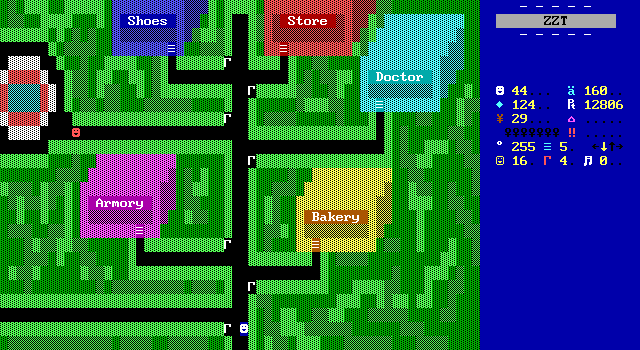
Towards the end of the game, Jersey Jake will find himself in a small village in 13th century England. There's a goal of finding a way past the troll that blocks access to the fountain which contains information on how to solve a puzzle and a key to access the castle. The troll is hungry so the player's first instinct is likely going to be to check out the bakery, though they'll find that in this shop, and nearly all the others nothing is actually offered for sale.
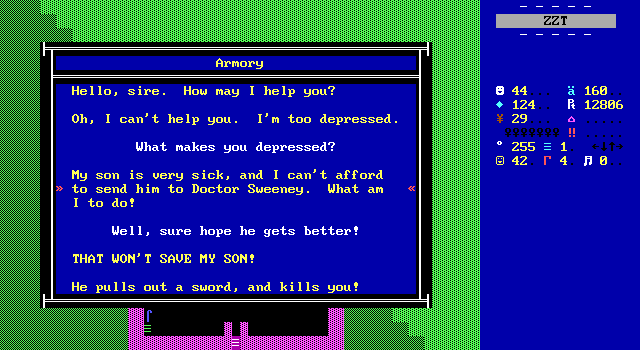
The armory meanwhile, is where it gets wild. Here the person behind the counter has a sick child and can't afford Tim Sweeney's prices. If you have a specific flag set you can offer to get the doctor for him. If you don't have it, which you won't if you end up exploring the buildings in a sensible bottom to top order, the object defaults to Jake's polite words and immediate death for it. It's incredible and comes out of nowhere.
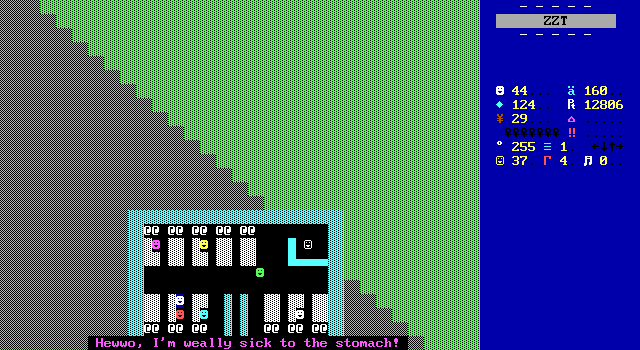
The quest chain actually begins with heading to Sweeney's clinic and learning about the importance of the fountain and getting past the troll. This sets a flag indicating that you're "friendly" with the good doctor.

Okay, so now you can actually be helpful and get rewarded for it. Or you can offer hope and get stabbed for it.
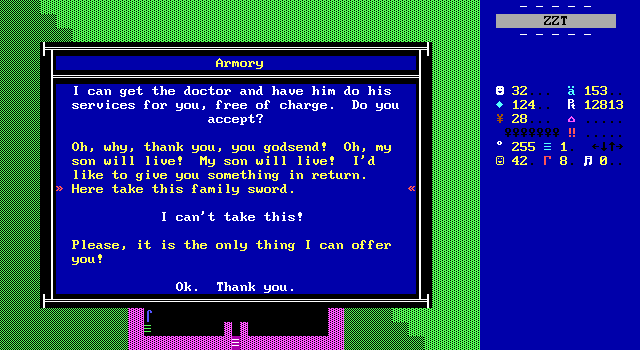
Jake is kind of just making this offer up on the spot actually. Sweeney said nothing about working for free to you. It's not even a case of you going back to the doctor to plead for treatment for the kid.
Regardless of what treatment the child will or won't get in the future though, Jake now has a fancy sword.
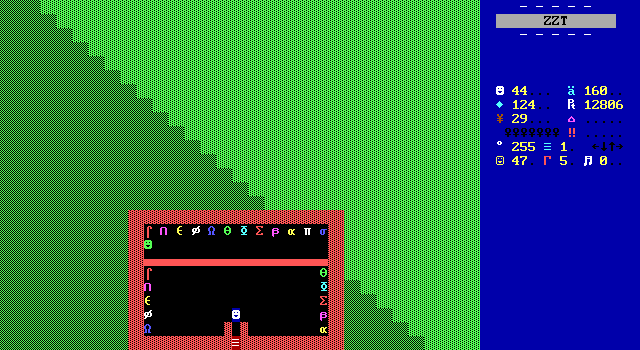
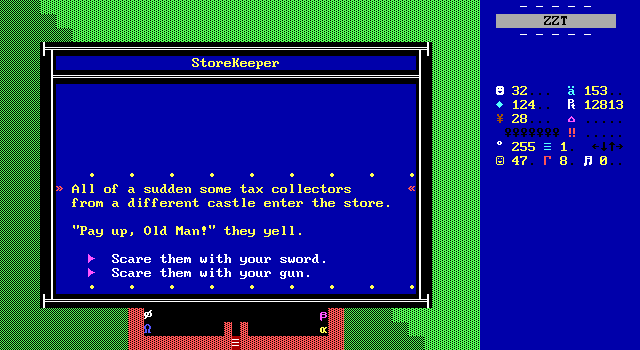
Heading to the store now results in dreaded tax collectors showing up. Unlike the armory, going in without the proper flag doesn't result in your death and instead the tax collectors just don't show up. With the framing of this, it's clear that the sword is going to be the correct weapon to brandish, but it's unclear if it's because you'll kill somebody who works for the kingdom with it or something else.
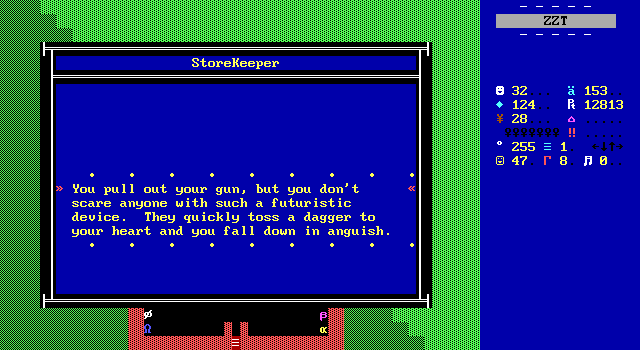
In one of the best moments of Ruby of Resurrection, the medieval people don't know what a gun is and opt to hurl a dagger at you without hesitation.
Awkwardly swinging the sword around goes a lot better. The tax collectors flee and as a reward Jake receives a golden shield.
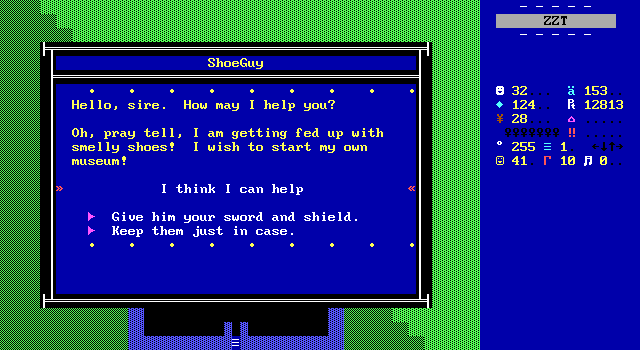
The sword and shield are clearly meant to be given away to the shoemaker so he can start a museum with them. I would have loved for this to connect with the museum in the present day in some way, but the opportunity goes squandered. Jake gets some cool shoes in exchange.
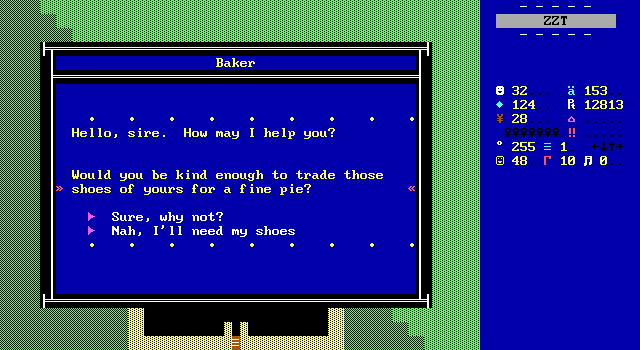
And the baker wants the shoes. Finally, Jake has a pie for the troll. The troll instantly disappears upon receiving the pie with no message displayed.
Rather dangerously this whole thing sets more and more flags without clearing them, eventually hitting the limit and beyond. Luckily, the linear nature of the rest of the game means that flags unintentionally overwriting other flags only results in a minor issue at the end of the game. Still though, this could have been game ruining if the quest was even slightly more involved than this!
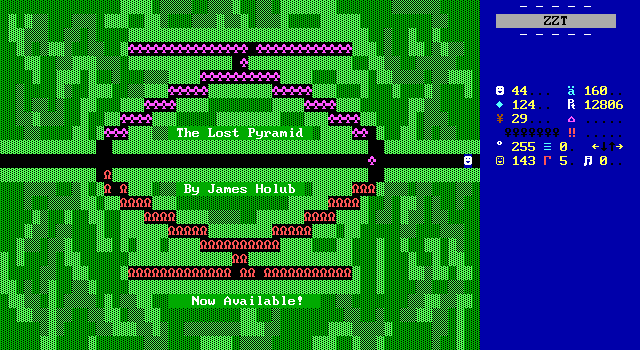
Once Jake makes it to England there's this single action board on the way to the castle that seems more advertisement than action honestly. I like the design of the room visually, however as far as playing it goes you're so clearly better off just running past everything only shooting in the horizontal line that runs the length of the board. There's no reward for fighting here other than points. Given the sheer number of enemies here though it's for the best that ignoring everything is a valid option.

